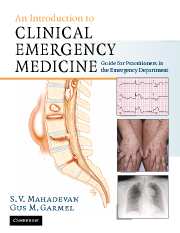Book contents
- Frontmatter
- Contents
- List of contributors
- Foreword
- Acknowledgments
- Dedication
- Section 1 Principles of Emergency Medicine
- Section 2 Primary Complaints
- 9 Abdominal pain
- 10 Abnormal behavior
- 11 Allergic reactions and anaphylactic syndromes
- 12 Altered mental status
- 13 Chest pain
- 14 Constipation
- 15 Crying and irritability
- 16 Diabetes-related emergencies
- 17 Diarrhea
- 18 Dizziness and vertigo
- 19 Ear pain, nosebleed and throat pain (ENT)
- 20 Extremity trauma
- 21 Eye pain, redness and visual loss
- 22 Fever in adults
- 23 Fever in children
- 24 Gastrointestinal bleeding
- 25 Headache
- 26 Hypertensive urgencies and emergencies
- 27 Joint pain
- 28 Low back pain
- 29 Pelvic pain
- 30 Rash
- 31 Scrotal pain
- 32 Seizures
- 33 Shortness of breath in adults
- 34 Shortness of breath in children
- 35 Syncope
- 36 Toxicologic emergencies
- 37 Urinary-related complaints
- 38 Vaginal bleeding
- 39 Vomiting
- 40 Weakness
- Section 3 Unique Issues in Emergency Medicine
- Section 4 Appendices
- Index
24 - Gastrointestinal bleeding
Published online by Cambridge University Press: 27 October 2009
- Frontmatter
- Contents
- List of contributors
- Foreword
- Acknowledgments
- Dedication
- Section 1 Principles of Emergency Medicine
- Section 2 Primary Complaints
- 9 Abdominal pain
- 10 Abnormal behavior
- 11 Allergic reactions and anaphylactic syndromes
- 12 Altered mental status
- 13 Chest pain
- 14 Constipation
- 15 Crying and irritability
- 16 Diabetes-related emergencies
- 17 Diarrhea
- 18 Dizziness and vertigo
- 19 Ear pain, nosebleed and throat pain (ENT)
- 20 Extremity trauma
- 21 Eye pain, redness and visual loss
- 22 Fever in adults
- 23 Fever in children
- 24 Gastrointestinal bleeding
- 25 Headache
- 26 Hypertensive urgencies and emergencies
- 27 Joint pain
- 28 Low back pain
- 29 Pelvic pain
- 30 Rash
- 31 Scrotal pain
- 32 Seizures
- 33 Shortness of breath in adults
- 34 Shortness of breath in children
- 35 Syncope
- 36 Toxicologic emergencies
- 37 Urinary-related complaints
- 38 Vaginal bleeding
- 39 Vomiting
- 40 Weakness
- Section 3 Unique Issues in Emergency Medicine
- Section 4 Appendices
- Index
Summary
Scope of the problem
Bleeding may occur anywhere along the gastrointestinal (GI) tract. Severity of bleeding may range from asymptomatic rectal bleeding to circulatory collapse from massive blood loss. The seriousness of the disorder may be difficult to assess initially, presenting a diagnostic and therapeutic challenge for emergency physicians.
GI bleeding (GIB) may occur at any age, most commonly between 40 and 79 years of age. Mortality is highest after the age of 60 years. GIB is divided into upper (UGIB) and lower (LGIB). UGIB occurs in 50–150/100,000 adults each year. There are 250,000 hospital admissions each year for UGIB, with costs of almost $1 billion.
Anatomic essentials
The ligament of Treitz crosses the small intestine at the junction of the duodenum and jejunum. Bleeding above the ligament of Treitz is considered UGIB; below this ligament it is considered LGIB. Hematemesis is the vomiting of blood. Coffee-ground emesis is from GIB in which blood has been in the stomach long enough to have been partially digested by stomach acid. UGIB usually results in the digestion of blood as it transits the small intestine. This results in melena (dark or black tarry stools), which is often foul-smelling. The passing of maroon or dark red stools is called hematochezia. This is usually from LGIB; however, this can also occur from brisk UGIB with a fast intestinal transit time. Bright red blood per rectum (BRBPR) is often from distal bleeding (descending colon, rectosigmoid, or rectum) or fast transit time.
- Type
- Chapter
- Information
- An Introduction to Clinical Emergency MedicineGuide for Practitioners in the Emergency Department, pp. 365 - 374Publisher: Cambridge University PressPrint publication year: 2005



